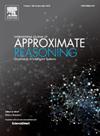Matrix-based approach for knowledge structure construction using variable precision models
IF 3
3区 计算机科学
Q2 COMPUTER SCIENCE, ARTIFICIAL INTELLIGENCE
引用次数: 0
Abstract
Assessment of knowledge acquiring and learning is a complex and multidimensional process that involves the evaluation and measurement of an individual's performance in the process of learning and acquiring knowledge. The concept of fuzzy skill encapsulates an individual's latent cognitive abilities and overall competence. In the disjunctive model, an individual must achieve proficiency in at least one relevant skill to solve an item. In contrast, the conjunctive model requires proficiency in all relevant skills. The disjunctive model's excessive leniency and the conjunctive model's excessive rigor have prompted the development of variable precision α-models to mediate between these extremes. Nonetheless, the variable precision α-model warrants further exploration.
Consequently, this paper is conducting a comprehensive analysis of the variable precision α-model, presenting three variants, and examining their respective properties. Additionally, no existing algorithm addresses the construction of the knowledge structure within this model. For this purpose, a new matrix operation is defined, and its properties related to fuzzy skill inclusion degree are investigated. The variable precision model is refined for constructing the knowledge structure, and the corresponding algorithm is designed. Moreover, the applicability of the matrix approach in constructing knowledge structures for variable precision models in the context of dynamic items is examined. Finally, a dataset is used to empirically evaluate the feasibility and effectiveness of the proposed algorithm.
基于矩阵的变精度模型知识结构构建方法
知识获取和学习的评估是一个复杂的、多维的过程,它涉及到对个人在学习和获取知识过程中的表现进行评价和测量。模糊技能的概念概括了个体潜在的认知能力和整体能力。在析取模型中,个体必须熟练掌握至少一项相关技能才能解决一个问题。相比之下,连接模式要求熟练掌握所有相关技能。析取模型的过度宽松和合取模型的过度严格促使了变精度α-模型的发展,以调解这两个极端。然而,变精度α-模型值得进一步探索。因此,本文对变精度α-模型进行了全面的分析,提出了三种变量,并考察了它们各自的性质。此外,没有现有的算法解决该模型中知识结构的构建。为此,定义了一种新的矩阵运算,并研究了其与模糊技能包含度相关的性质。对构建知识结构的变精度模型进行了细化,并设计了相应的算法。此外,本文还探讨了矩阵方法在动态项目的变精度模型知识结构构建中的适用性。最后,利用数据集对所提算法的可行性和有效性进行了实证评估。
本文章由计算机程序翻译,如有差异,请以英文原文为准。
求助全文
约1分钟内获得全文
求助全文
来源期刊

International Journal of Approximate Reasoning
工程技术-计算机:人工智能
CiteScore
6.90
自引率
12.80%
发文量
170
审稿时长
67 days
期刊介绍:
The International Journal of Approximate Reasoning is intended to serve as a forum for the treatment of imprecision and uncertainty in Artificial and Computational Intelligence, covering both the foundations of uncertainty theories, and the design of intelligent systems for scientific and engineering applications. It publishes high-quality research papers describing theoretical developments or innovative applications, as well as review articles on topics of general interest.
Relevant topics include, but are not limited to, probabilistic reasoning and Bayesian networks, imprecise probabilities, random sets, belief functions (Dempster-Shafer theory), possibility theory, fuzzy sets, rough sets, decision theory, non-additive measures and integrals, qualitative reasoning about uncertainty, comparative probability orderings, game-theoretic probability, default reasoning, nonstandard logics, argumentation systems, inconsistency tolerant reasoning, elicitation techniques, philosophical foundations and psychological models of uncertain reasoning.
Domains of application for uncertain reasoning systems include risk analysis and assessment, information retrieval and database design, information fusion, machine learning, data and web mining, computer vision, image and signal processing, intelligent data analysis, statistics, multi-agent systems, etc.
 求助内容:
求助内容: 应助结果提醒方式:
应助结果提醒方式:


